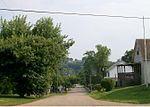Dysart Woods
Allegheny PlateauNational Natural Landmarks in OhioNature reserves in OhioOhio UniversityProtected areas of Belmont County, Ohio
Dysart Woods is the largest remaining tract of old growth forest in southeastern Ohio. It is located in the unglaciated Allegheny Plateau in Belmont County almost five miles (8 km) from the village of Belmont on Ohio State Route 147.
Excerpt from the Wikipedia article Dysart Woods (License: CC BY-SA 3.0, Authors).Dysart Woods
Dysart Woods Road,
Geographical coordinates (GPS) Address Nearby Places Show on map
Geographical coordinates (GPS)
| Latitude | Longitude |
|---|---|
| N 39.9846 ° | E -80.9976 ° |
Address
Dysart Woods Road 61644
43718
Ohio, United States
Open on Google Maps




